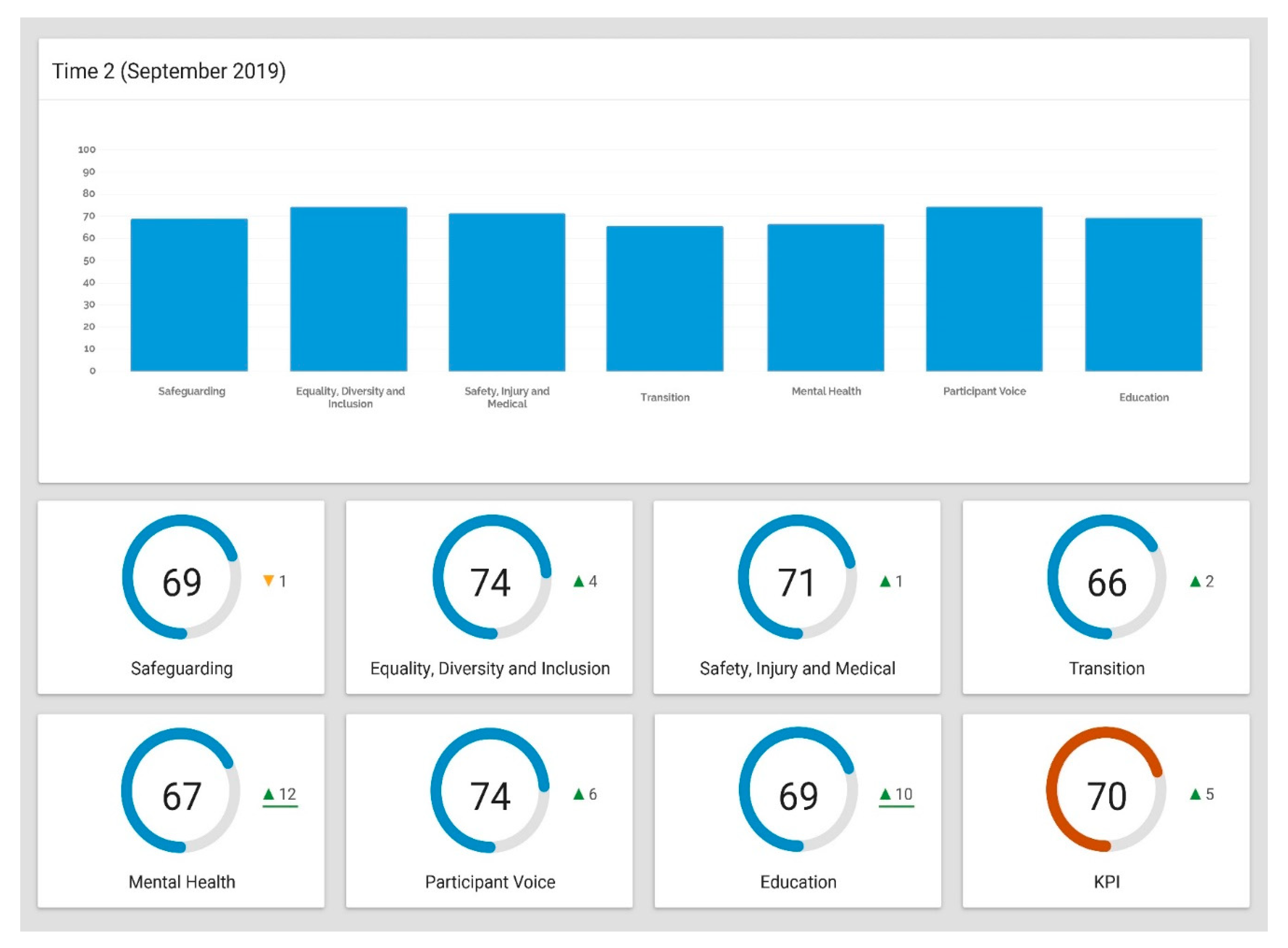Clear Data as a New Data Typology to Enhance Sustainability in Sport
Abstract
1. Introduction
2. Instrument Validation
2.1. Item Development
2.2. Content Validation
2.3. Instrument Reliability
3. Instrument Utility
4. Discussion
Author Contributions
Funding
Conflicts of Interest
References
- Albu, O.B.; Flyverbom, M. Organizational transparency: Conceptualizations, conditions, and consequences. Bus. Soc. 2019, 58, 268–297. [Google Scholar] [CrossRef]
- Kitchin, T. The Data Revolution; Sage: London, UK, 2014. [Google Scholar]
- De Mauro, A.; Greco, M.; Grimaldi, M. A formal definition of big data based on its essential features. Libr. Rev. 2016, 65, 122–135. [Google Scholar] [CrossRef]
- Ayre, L.B.; Craner, J. Open data: What it is and why you should care. Public Libr. Quart 2010, 36, 173–184. [Google Scholar] [CrossRef]
- Darace, D.; Schopfel, J. Grey Literature in Library and Information Studies; DeGruyter Saur: Berlin, Germany, 2010. [Google Scholar]
- Parida, V.; Wincent, J. Why and how to compete through sustainability. Int. Entrep. Manag. J. 2019, 15, 1–19. [Google Scholar] [CrossRef]
- International Olympic Committee. Sustainability Essentials; International Olympic Committee: Lausanne, Switzerland, 2016. [Google Scholar]
- Duty of Care in Sport Review. Available online: https://www.gov.uk/governmentpublications/duty-of-care-in-sport-review (accessed on 30 April 2018).
- Sport Duty of Care Review: Call for Evidence. Available online: www.gov.uk/government/consultations/sport-duty-of-care-review-call-for-evidence (accessed on 30 April 2018).
- Grant, J.S.; Davis, L.L. Selection and use of content experts for instrument development. Res. Nurs. Health 1997, 20, 269–274. [Google Scholar] [CrossRef]
- Wynd, C.A.; Schmidt, B.; Schaefer, M.A. Two quantitative approaches for estimating content validity. West J. Nurs. Res. 2003, 25, 508–518. [Google Scholar] [CrossRef]
- Polit, D.F.; Beck, C.T.; Owen, S.V. Is the CVI an acceptable indicator of content validity? Appraisal and recommendations. Res. Nurs. Health 2007, 30, 459–467. [Google Scholar] [CrossRef] [PubMed]
- Anastasi, A. Psychological Testing, 6th ed.; Macmillan: New York, NY, USA, 1988. [Google Scholar]
- Parmenter, D. Key Performance Indicators, 4th ed.; Wiley: London, UK, 2019. [Google Scholar]
- Morrison-Saunders, A.; Pope, J. Conceptualizing and managing trade-offs in sustainability assessment. Environ. Impact Assess. Rev. 2013, 38, 54–63. [Google Scholar] [CrossRef]
- Geeraert, A. National Sports Governance Observer: Final Report; Danish Institute for Sports Studies: Aarhus, Denmark, 2018. [Google Scholar]


| Item | T1 N | T1 Mean (CI) | T2 N | T2 Mean (CI) | ICC |
|---|---|---|---|---|---|
| Safeguarding | |||||
| - Perceived Support | 107 | 6.76 (±0.32) | 107 | 6.83 (±0.30) | 0.85 |
| - Support Needed | Yes = 18; No = 89 | Yes = 17; No = 90 | 0.99 | ||
| - Received Support | 18 | 6.44 (±0.49) | 17 | 6.58 (±0.49) | 0.93 |
| Equality, Diversity, and Inclusion | |||||
| - Perceived Support | 107 | 6.82 (±0.38) | 107 | 6.79 (±0.37) | 0.89 |
| - Support Needed | Yes = 19; No = 88 | Yes = 18; No = 89 | 0.99 | ||
| - Received Support | 19 | 7.47 (±0.57) | 18 | 7.5 (±0.56) | 0.78 |
| Safety, Injury, and Medical | |||||
| - Perceived Support | 107 | 6.73 (±0.35) | 107 | 6.79 (±0.35) | 0.79 |
| - Support Needed | Yes = 31; No = 76 | Yes = 29; No = 78 | 0.98 | ||
| - Received Support | 31 | 7.81 (±0.71) | 29 | 7.83 (±0.69) | 0.91 |
| Transition | |||||
| - Perceived Support | 107 | 6.64 (±0.30) | 107 | 6.56 (±0.30) | 0.78 |
| - Support Needed | Yes = 16; No = 91 | Yes = 15; No = 92 | 0.99 | ||
| - Received Support | 16 | 7.81 (±0.55) | 15 | 7.87 (±0.53) | 0.81 |
| Mental Health | |||||
| - Perceived Support | 107 | 6.66 (±0.31) | 105 | 6.63 (±0.30) | 0.83 |
| - Support Needed | Yes = 15; No = 92 | Yes = 16; No = 89 | 0.98 | ||
| - Received Support | 15 | 6.53 (±0.44) | 16 | 6.56 (±0.47) | 0.84 |
| Representation of Participant’s Voice | |||||
| - Perceived Support | 107 | 6.49 (±0.34) | 103 | 6.45 (±0.35) | 0.79 |
| - Support Needed | Yes = 20; No = 87 | Yes = 18; No = 85 | 0.99 | ||
| - Received Support | 20 | 7.4 (±0.58) | 18 | 7.44 (±0.58) | 0.92 |
| Education | |||||
| - Perceived Support | 107 | 6.54 (±0.36) | 102 | 6.59 (±0.37) | 0.84 |
| - Support Needed | Yes = 23; No = 84 | Yes = 20; No = 82 | 0.98 | ||
| - Received Support | 23 | 7.26 (±0.61) | 20 | 7.3 (±0.61) | 0.91 |
© 2020 by the authors. Licensee MDPI, Basel, Switzerland. This article is an open access article distributed under the terms and conditions of the Creative Commons Attribution (CC BY) license (http://creativecommons.org/licenses/by/4.0/).
Share and Cite
Lavallee, D.; Lowder, J.; Lowder, J. Clear Data as a New Data Typology to Enhance Sustainability in Sport. Sustainability 2020, 12, 4527. https://doi.org/10.3390/su12114527
Lavallee D, Lowder J, Lowder J. Clear Data as a New Data Typology to Enhance Sustainability in Sport. Sustainability. 2020; 12(11):4527. https://doi.org/10.3390/su12114527
Chicago/Turabian StyleLavallee, David, Jeff Lowder, and Jane Lowder. 2020. "Clear Data as a New Data Typology to Enhance Sustainability in Sport" Sustainability 12, no. 11: 4527. https://doi.org/10.3390/su12114527
APA StyleLavallee, D., Lowder, J., & Lowder, J. (2020). Clear Data as a New Data Typology to Enhance Sustainability in Sport. Sustainability, 12(11), 4527. https://doi.org/10.3390/su12114527





